Keynotes 10
Japan - Land of the Rising Sun
Differences and similarities compared to other East
Asian nations
- Different from Vietnam or Korea, Japan was never
forced to live under Chinese occupation or take over Chinese cultural acievements,
but chose to select from foreign cultures, - in the early days from China
and Korea, later from the West -, whatever promised to enhanced the quality
of life. This pattern pertained to concrete objects as well as abstract concepts.
No arrogance limited the Japanese in adopting ideas and techniques, which
they then altered and developed according to their own needs.
- The feudal system of hereditary ranks and clear class
distinctions was preserved until the 1860s. Like in Korea, the [military]
aristocracy ruled the country and had access to education. This social system
prohibited political unification until the 17th century.
- The population was small compared to the densely
populated areas in China and Vietnam, which were surrounded by cultivated
land. Similar to Korea, Japan has very limited space for cultivation (17%
of the territory). It is the country with the highest cosumption of chemical
fertilizer in the world to which the acidic volcanic soil contributes.
Timeline
Mythical beginnings: The myth of the siblings Izanagi
and Izanami who create the Japanese islands, and their daughter Amaterasu, the
Kami of the Sun, are recorded in the oldest Japanese historiographical works
Kojiki (712; Record of Ancient Matters) and Nihongi
(or Nihon shoki, History of Japan; 720). The records were created to
provide Japan with an impressive and long history, which could be used by the
rulers who linked their origins to the myth of Amaterasu to legitimize their
ower. These historical writings were based on the Chinese model.
10.000 BCE oldest pottery in the world
8.000 BCE Jomon: pit dwelings; pottery without the potter's wheel
The 'Age of Cultural Borrowing'
3rd BCE - 6th cent. CE
Yayoi: dwellings on stilts; rice cultivation; simultaneous
begin of use of bronze and iron: agricultural revolution, potter's wheel (Chinese
influence): hard pottery often in pale orange; Kofun = 'keyhole'-shaped tombs
with Haniwa (=pottery models of warriors, houses, animals etc.) as tomb protectors/
indicators of 'tomb territory' (Korean influence)
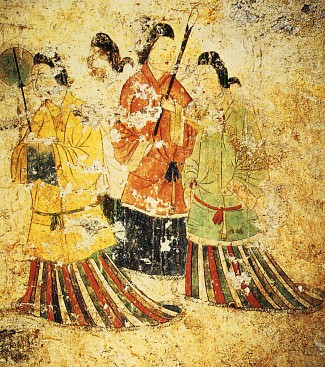
Yayoi period Tomb mural (Asukamura, Nara prefecture)
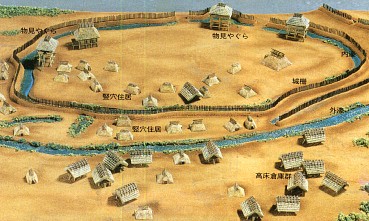
Yayoi village (model)
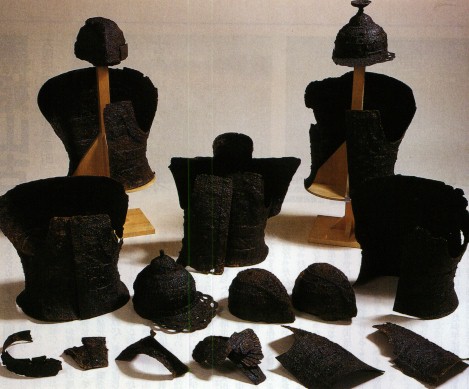
Armor found in a Yayoi tomb
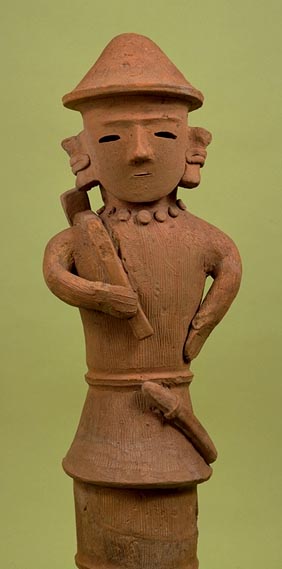
Haniwa figurine
3rd cent. CE competing regional states; some
states are united by Queen Pimiko, a shaman queen
Yamato area (Kyoto-Osaka): center of tribal uji-clan
organization in which clans are consolidated into a state; clan leaders have
political and religious function; their position is hereditary; clans are
devoted to ancestor worship and venerate Kami (=supernatural presence/force
active in nature as well as in [manmade] objects). Uji members have aristocratic
titles (in analogy with Korean titles); non-uji members are artisans, many
of whom are from Korea (Paekche; Kaya); indigenous workers; peasants
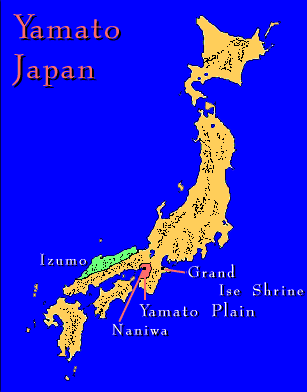
Shinto: The "Way of the gods/deities":
animistic-shamanistic cult (influenced by Central Asian shamanistic traditions)
without theological or philosophical canon; no strictly organized religious
community. Focus: ritual cleansing to preserve/achieve purity (Rituals performed
at shrines, in Sumo, in everyday hygiene); love of nature;
Early rulers served as Shinto priests/priestess.
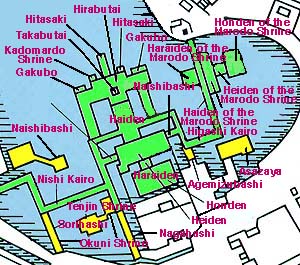
Map of Itsukushima Shrine, important center of Shinto
until today

Sumo wrestlers

Shinto shrine entrance: The torii gate indicates
the sacred ground of the shrine
5th -6th century: Chinese
characters are adopted for the transcription of Japanese names
513 Confucianism reaches Japan via Paekche with a scholar of
the 'Five Classics';
552 Buddhism comes to Japan (via Korea); Kami take 'human shape'
(in depictions, dancers as impersonators etc.);
554 Scholars from Paekche bring divination practices,
medical knowledge, Confucian ideas, and the Chinese calendar to Japan
562 Territory of Kaya (Korea) taken over by Silla; Japan
looses its cultural stronghold in Korea; migration of Korean families (artisans)
to Japan lasts until 9th century
604-622 During the reign of Prince Shotoku, the first
Tenno = Heavenly Ruler of Japan, Confucian ideas make their way to Japanese
ruling class. Buddhism becomes the state religion; Prince Shotoku supports Buddhist
teachings and writes interpretations of several sutras; with Buddhism Tang civilization
is imported to Japan on a grand scale:
the 17 Article Constitution replaces the uji-organization
and emphasizes the supremacy of the ruler/emperor; a bureaucratic administration
with 26 ranks is established; the officials are selected by examinations;
recruitment of officials from the ranks of the aristocracy
3 year-long embassies are sent to China (607, 608,
614 CE); scholars and students, monks and artists bring back their knowledge
of Tang civilization: architecture, urban planning, Buddhist and Confucian
teachings in Chinese characters, Chinese laws, taxation system with taxes
in kind (rice, textiles) and corvèe services make their way to Japan;
construction of Horyuji and Todaiji Temples in Nara by decree of Prince Shotoku;
increased spreading of the Chinese script

Horyuji Temple: oldest wooden buildings in the world
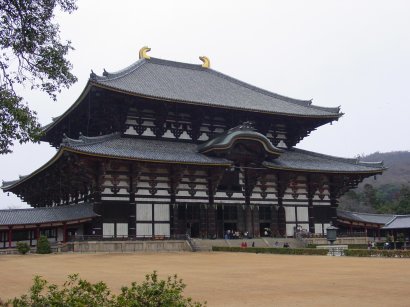
Todaiji Tempel
622 Rebellion of former uji-leaders
after Prince Shotoku's death; Fujiwara clan becomes dominant; promotion of Shinto
instead of Buddhism;
645 The Fujiwara clan leaders install their own Tenno:
Tenchi who leads the Taika ('Great Change') refom: the capital is moved to Naniwa
(Osaka); taxation and law code are reformed according to the Chinese model;
Confucian ideas become dominant.
The Fujiwara clan dominates politics to a degree that
left some emperors in a powerless position who tried to conduct a land reform
in order to limit the power of the important landowners (shoen),
redistribute land to the peasants, and create tax revenue for the state.
653-669 Five additional embassies to China
710 Capital moved to Nara "first city of Japan";
the layout of Nara follows the model of Chang'an (difference: no city wall)[Nara
was supposed to become the permanent capital of Japan; before the establishing
of Nara as the capital, the capital had moved with each death of an emperor]
758/760 Compilation of the Manyôshu
[Collection of 10000 Leaves]- poetry anthology; 4516 poems in Japanese
Buddhism promoted again; construction of Buddhist temples;
Shôsôin (treasure storehouse for imports from China including objects
from other countries such as Persia and Central Asian kingdoms)
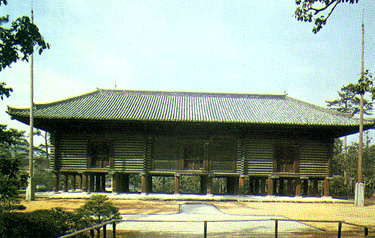
Shôsôin Treasure House
794-1185 Heian Period - Rule of the Fujiwara
clan in Kyoto (858-1185)
Heian (Kyoto) becomes the capital (794-1868); the
city layout is based on the map of Chang'an; Heian culture preserves Tang
culture (tea ceremony, dance, court music, food, garden culture, bonsai).
While the aristocrats live in Tang style luxury, the countryside was backward
and unrefined.
The role of the Tenno is reduced to his ceremonical
functions as the head of the shinto cult; political power is concentrated
in the hands of the leading aristocratic families;
the state territory is divided into provines and districts (Chinese model);
the central government consists of eight ministries (Chinese model: 6 ministries;
one additional ministry supervises the Imperial Household; another one the
Shinto cult; this seems exaggerated when comparing population numbers: China:
60 mio., Japan 4-5 mio inhabitants;
the local administration is in the hands of local clan leaders who also organize
their own defense;
local historiography: local gazetteers report about local geography, history,
economy, legends, politics, famous personalities.
Private estates of aristocratic families
and monasteries (shoen) become prominent; they are worked by tenants
and are often exempted from taxation because they are protected by the ruling
clans; while weakening the central government (lack of tax revenues) they
grow increasingly independent. They support local development but most of
the locally created wealth accumulates in their coffers. In order to defend
their estates they recruit local armies which become increasingly powerful.
Buddhist monasteries begin to have their own armies as well. The development
of the Samurai class within the hereditary aristocracy grows into a power
challenging force [return of the uji-clan organization model 'through
the back door'].
Differences to the Chinese government model:
- no eunuchs
- no shift from a dominant aristocracy to a dominant bureaucracy: emperor
and bureaucrats (of aristocratic background) vs. aristocratic clans; family
more important than personal merits
9th cent. Buddhism: The Shingon (magical formulas
and incantations; brought to Japan in 806 by monk Kobo Daishi)
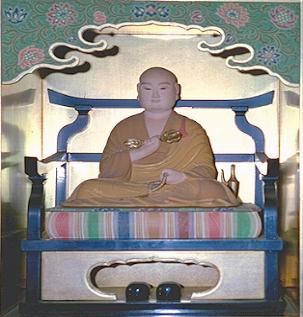 Kobo
Daishi (founded a monastery on Mt. Koya near Nara)
Kobo
Daishi (founded a monastery on Mt. Koya near Nara)
and Tendai (chin. Tiantai; incorporated
elements from Hinduism and Daoism; strict monastic rules; transmitted by Dengyo
Daishi when returning from China in 805) sects of Buddhism become dominant
at court. Monk Ennin from the Enryakuji Temple in Kyoto travels to China and
returns with diaries reporting about Tang lifestyle), while the population
follows a Mahayana mixture of Pure Land (Jingtu)/Amida Buddhism from China
and Shinto.
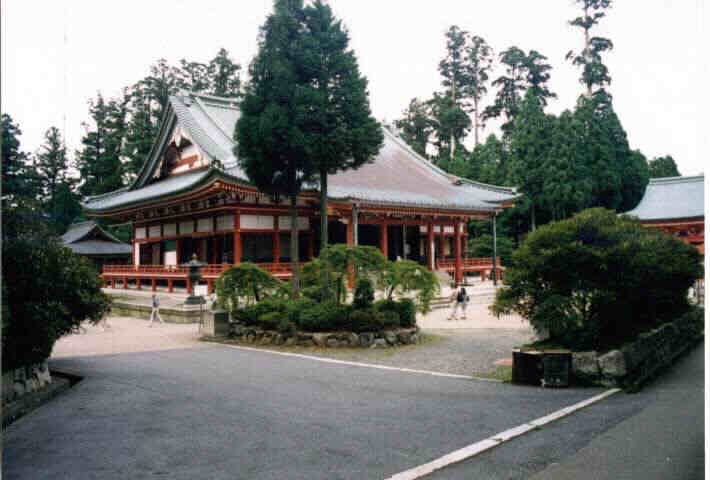
Enryakuji Temple, Kyoto
Literature: Calligraphy is acknowleged as the highest
art form; narrative painting becomes prominent (scrolls and multi-panel screens),
especially in relation to the illustration of the novels by Murasaki Shikibu
(ca. 978- ca. 1015): The Tale of Genji (1016) and Sei Shonagon: Pillow
Book (ca. 1000), as well as diaries by court ladies; poetry (Tanka, Haiku)
is written in Kanji (Chinese characters) as well as Kana (Japanese characters;
especially used by women)
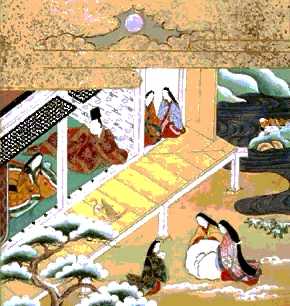 Illustration of The Tales of Prince Genji
Illustration of The Tales of Prince Genji
Historiography: Local gazetteers are compiled by official
order. They record local history, give economic data (tax exempts, local products,
local politics and involved local celebrities, legends etc.)
Court culture: Centered around Chinese ideas of self-cultivation
predominantly expressed in poetry. Garden culture develops beyond the Song
Chinese model in a rigidly planned style, selecting plants, rocks, architectural
structures like gates or pavilions according the ideal of creating 'windows'
that provide views of nature in harmony.
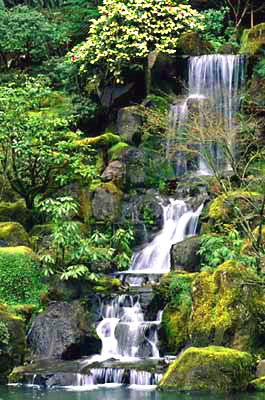

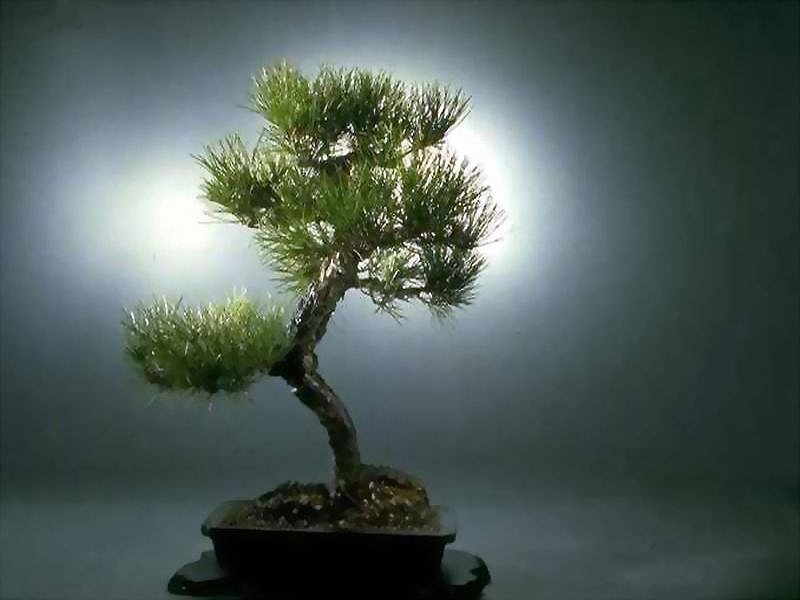
Bonsai
Clothing becomes an art which is used to display (and
judge) taste by combining colors and patterns of the most refined artistic
textiles.
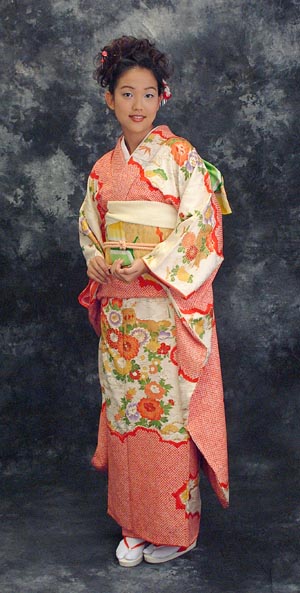
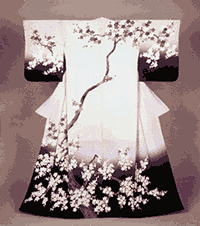
Kimono in the Philadelphia Museum of Art











 Kobo
Daishi (founded a monastery on Mt. Koya near Nara)
Kobo
Daishi (founded a monastery on Mt. Koya near Nara)
 Illustration of The Tales of Prince Genji
Illustration of The Tales of Prince Genji



